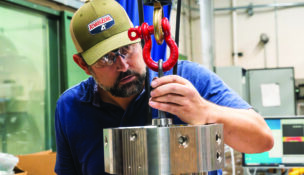How Colorado is Reducing Food Waste to Benefit the Climate
The amount, impact and lost opportunity of the food we waste is enormous
Kevin Afflerbaugh //January 17, 2018//


How Colorado is Reducing Food Waste to Benefit the Climate
The amount, impact and lost opportunity of the food we waste is enormous
Kevin Afflerbaugh //January 17, 2018//

Over the past decade, composting has shed its hippie-lifestyle image and become a mainstay in government policy efforts to increase diversion rates and reduce greenhouse gas emissions. Organic waste in landfills produces methane, a greenhouse gas with 86 times more global warming potential (GWP) over 20 years than CO2. Composting is an important piece of the puzzle in diversion from landfills and overall climate stewardship, but it isn't the best use of our excess and uneaten food.
By any measure, the amount, impact and lost opportunity of the food we waste is enormous. The Natural Resources Defense Council (NRDC) estimates as much as 40 percent of the food produced in the United States, 35 million tons of edible food, goes uneaten. An unacceptable statistic in a country where 42 million people, including one in five Colorado children, lack consistent access to adequate food. A staggering 300 million barrels of oil and 25 perent of the fresh water consumed in the U.S. goes to producing food that will ultimately go uneaten. Wasted energy, pesticides, labor, land and fertilizer invested in growing, transportation, storage and distribution amplify the economic and environmental impacts.
HOW DOES THIS HAPPEN?
Consumer demand for choice, abundance and aesthetic perfection means waste is built-in to our food supply chain. Nearly 30 percent of fruits and vegetables are left to rot on the farm, either because they are "ugly" and don't meet visual quality standards, or demand has shifted. Grocers order more than will sell to maintain those towers of color built to tantalize us in the produce aisles, and prepared food cases are kept stocked until the end of the day after which the food is tossed.
An unclear, inconsistent food dating system also plays a part. Contrary to what is widely believed, packaging dates generally do not indicate that a product is spoiled or unsafe. Rather, they are often indicative of the date before which the product is at its freshest.
Rounding out the list of culprits are excessive portion sizes, improper food storage and lack of meal planning, leading to purchasing more than we use.
STOP THE MADNESS
Food waste represents 21.6 percent of our total waste stream to landfills, and is responsible for at least 2.6 percent of U.S. greenhouse gas emissions, the equivalent of an additional 37 million cars on the road. Every food-insecure American could be fed if we captured just one-third of the food we waste. All told, 50 percent more food is wasted today and in the 1970s, and it doesn't have to be this way.
Together, the USDA and EPA have set national goals of a 50 percent reduction of wasted food by 2030. To guide those efforts, the EPA developed a recommended food recovery hierarchy. At the top of the list is source reduction, followed by feeding people, then feeding animals, industrial uses such as composting and fuel, and, least prefered, sending materials to the landfill. The recently updated NRDC report: "Wasted: How America is losing up to 40 percent of its food from farm to fork to landfill," offers an in-depth analysis of the main drivers of food waste and an extensive list of potential operational remedies for every link in the food delivery and use chain, based on the EPA hierarchy.
 By embracing the hierarchy and mining the NRDC recommendations, food businesses such as grocers, caterers and restaurants, institutions such as hospitals, schools and senior living centers, can make a big dent in the problem. Grocers can streamline their inventories, discount older items instead of throwing them away, improve stock rotation and utilize damaged or ugly product in prepared food offerings. Restaurants and institutions can reduce portions, streamline menus and repurpose food.
By embracing the hierarchy and mining the NRDC recommendations, food businesses such as grocers, caterers and restaurants, institutions such as hospitals, schools and senior living centers, can make a big dent in the problem. Grocers can streamline their inventories, discount older items instead of throwing them away, improve stock rotation and utilize damaged or ugly product in prepared food offerings. Restaurants and institutions can reduce portions, streamline menus and repurpose food.
Then there's food banks and rescue organizations. Thanks to technology, logistics are increasingly streamlined, matching donors and recipients with efficiency that has transformed a once slow, clunky process into nimble hub-and-spoke networks. Colorado-based We Don't Waste, a nonprofit that connects excess food donors with community-based agencies that feed the hungry in Denver and the Front Range, has recovered more than 11 million meals since 2009. Liability is often cited as a barrier to food donation, but donors that meet food safety requirements are protected by the Bill Emerson Good Samaritan Donation Act of 1996.
In the Boulder and Broomfield areas, it is estimated that there is likely more than enough food being discarded to meet the needs of all food-insecure people in the area. Organizations at work recovering food in the area include:
- Community Food Share
- Boulder Food Rescue – which redistributes perishable food with volunteers on bicycles
- Food Donation Connection – which serves as a connector between restaurants and recipient agencies
As with any wasted resource, waste in the food supply chain is also an entrepreneurial opportunity. FoodMaven, an agriculture-tech startup founded in 2015 and based in Colorado Springs, is a for-profit venture with a mission to keep food out of landfills. The company has created an online marketplace for high quality, local and oversupplied food offered at a steep discount to restaurants and institutional kitchens.
Regardless of what business we're in, at the end of the day, we're all consumers and it's our refrigerators, pantries and leftovers that are responsible for the largest amount – 43 percent – of food wasted in the U.S., costing the average family of four a whopping $1,500 to $1,800 annually. SaveTheFood.com was developed specifically to help consumers mend their food wasting ways. Pay them a visit for tips on everything from meal planning and shopping, to storage and food sharing. While you're there, check out their short video, "The Extraordinary Life and Times of Strawberry." Then go see what's hiding in the back of your refrigerator before it's too late.
Kevin Afflerbaugh of Western Disposal writes an occasional column about green business practices.

























